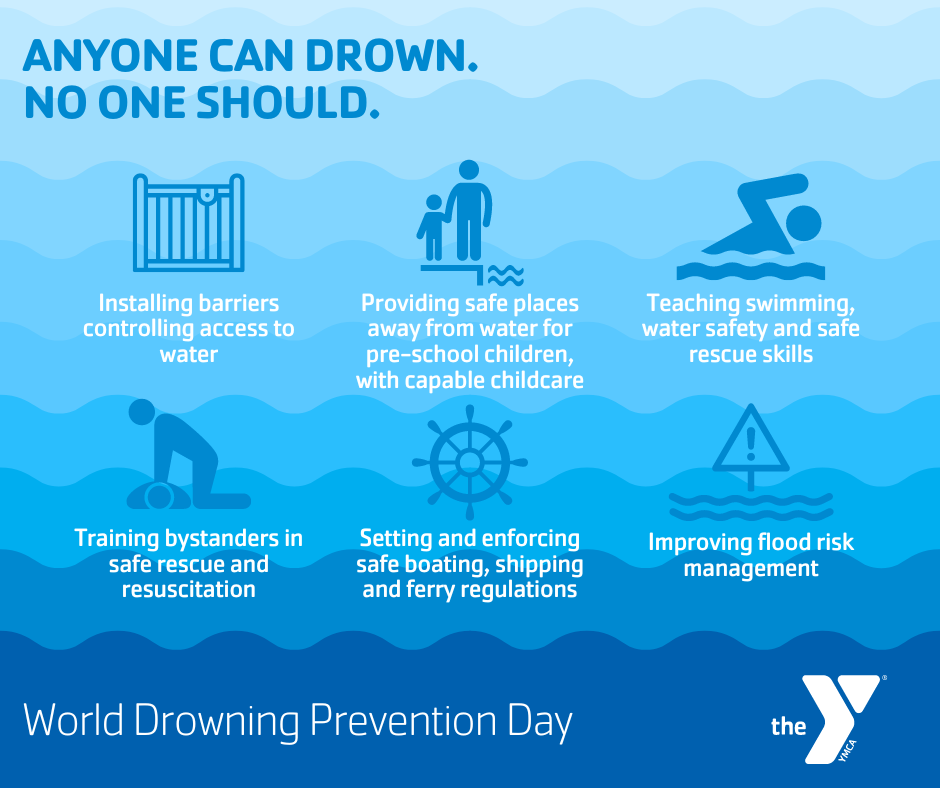
Anyone can drown. No one should. July 25 is World Drowning Prevention Day, set forth by The United Nations (UN) and World Health Organization (WHO). The Goldsboro Family YMCA is joining in on raising drowning prevention awareness as a public health issue. Visit who.int/campaigns/world-drowning-prevention-day to learn more about this global campaign, six low-cost, evidence-based interventions and what you can do in your household and local community. In 2023, the 76th World Health Assembly adopted its first ever resolution on drowning prevention. The resolution accepts the invitation of the UN General Assembly for WHO to coordinate actions within the UN system on drowning prevention and facilitate the observance of World Drowning Prevention Day on July 25 each year. Drowning has caused over 2.5 million deaths in the last decade. Globally, the highest drowning rates occur among children aged 1–4 years, followed by children aged 5–9 years. The human, social and economic toll of these losses is intolerably high, and entirely preventable. North Carolina has experienced a significant increase in drowning incidents this year, including a tragic fatal drowning at a backyard pool in Wayne County. 
Here are six evidence-based, low-cost drowning prevention interventions that countries and organizations can use to drastically reduce the risk of drowning:
· Installing barriers controlling access to water
· Providing safe places away from water for pre-school children, with capable childcare
· Teaching swimming, water safety and safe rescue skills
· Training bystanders in safe rescue and resuscitation
· Setting and enforcing safe boating, shipping and ferry regulations
· Improving flood risk management
Disparities in Drowning
As an organization dedicated to racial equity, we recognize the disparities in drowning rates among different racial groups and aim to shed light on these inequities to promote awareness and drive positive change. Understanding and addressing these disparities is crucial for creating effective drowning prevention strategies tailored to diverse communities. Here are some key bullet points highlighting racial disparities in drowning:
African American Children:
-
African American children ages 5-19 drown in swimming pools at rates 5.5 times higher than those of white children.
-
Lack of swimming proficiency and access to swimming facilities are significant factors.
Hispanic Children:
-
Hispanic children have higher drowning rates compared to white children.
-
Barriers include limited access to swimming lessons and cultural factors.
American Indian and Alaska Native People:
-
The fatal drowning rate for American Indian and Alaska Native people is about twice that of white people across all ages.
-
Higher exposure to natural bodies of water and lack of swimming skills contribute to this disparity.
Socioeconomic Factors:
-
Lower-income communities, often with higher proportions of minority populations, have less access to swimming lessons and safe swimming environments.
-
Public pools in low-income neighborhoods are often less maintained or nonexistent.
Cultural and Historical Factors:
-
Historical segregation and exclusion from public swimming facilities have contributed to generational fear of water and lack of swimming skills among some racial groups.
-
Cultural perceptions and priorities around swimming can influence participation in swimming lessons and water safety practices.
Our Commitment to You
Our commitment to the community extends deeply into ensuring water safety for all, reflecting our dedication to creating a secure and knowledgeable environment. We offer comprehensive swim lessons tailored to all ages and skill levels, ensuring that everyone, from beginners to advanced swimmers, has the opportunity to become confident and proficient in the water. Recognizing the importance of early education, we integrate water safety education into our Early Childhood Education programs to instill safe practices and awareness from a young age, building a foundation for lifelong safety. The Y has significantly increased its participation units from last year by implementing a new group lesson program that expands access to swim lessons for more people. Through this program, we have served approximately 35% more individuals compared to last year.
In addition to our swim lessons, we offer lifeguard certification trainings, equipping participants with essential lifesaving skills and knowledge to respond effectively in emergencies. These certification programs are designed to empower individuals with the confidence and competence needed to act swiftly and appropriately, potentially saving lives and ensuring the safety of our community members.
Our efforts extend beyond our own programs as we actively partner with local organizations to ensure that water safety resources are accessible to everyone in the community. By collaborating with schools, community centers, and other local entities, we aim to reach as many people as possible, reinforcing our dedication to a safer and more informed community. Through these partnerships, we work to remove barriers and create opportunities for all individuals to learn about and practice water safety, ultimately fostering a culture of safety and preparedness in our community.
We are proud to have served:
Swim Lessons (Group & Private): 242 people
Lifeguard Certification Course: 44 people
On World Drowning Prevention Day, discover how the Y can help your family be safe around water year-round. Visit https://www.goldsboroymca.org/programs/aquatics to learn more.
